1.2 54Productivity and Growth
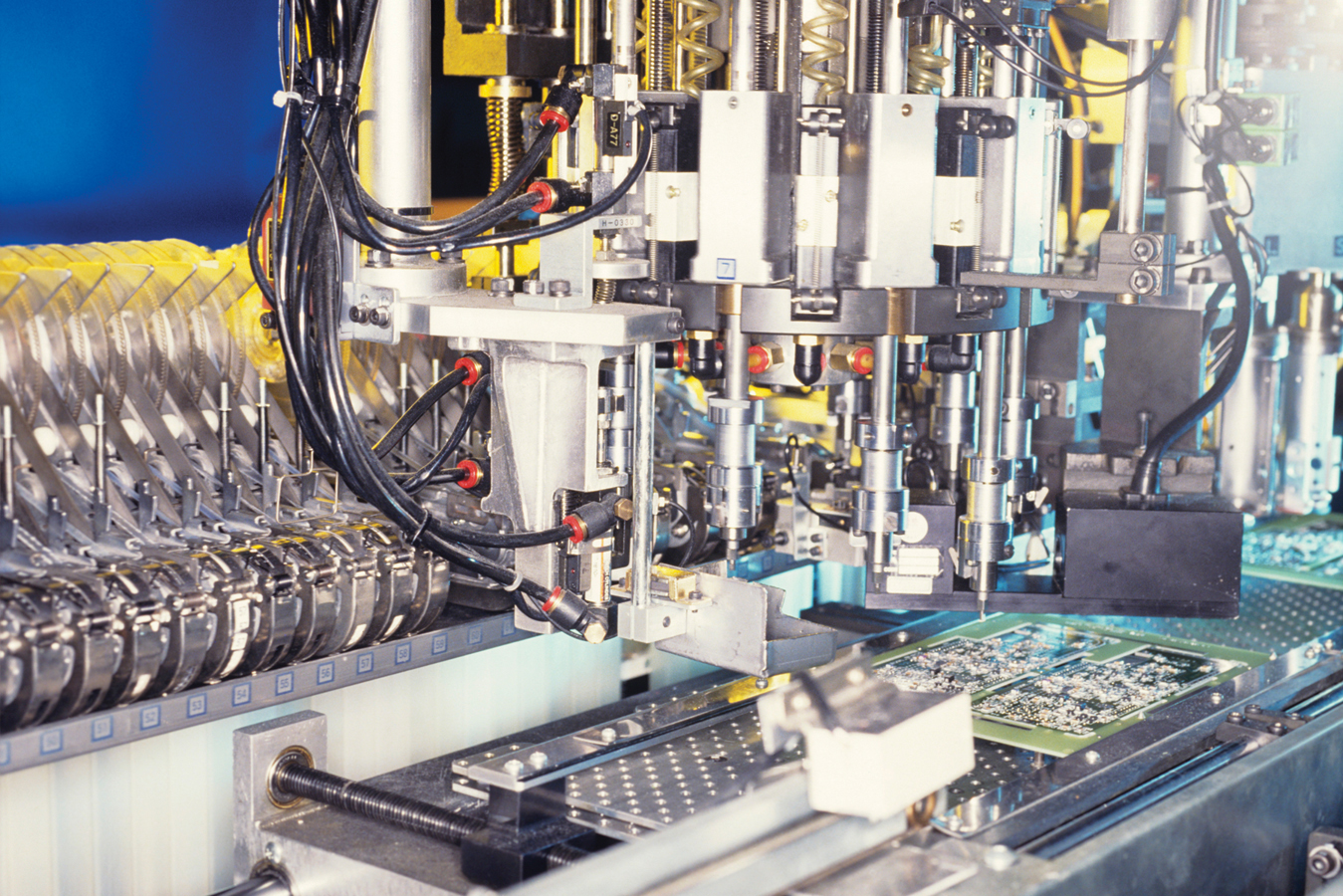
WHAT YOU WILL LEARN
 How changes in productivity are illustrated using an aggregate production function
How changes in productivity are illustrated using an aggregate production function
 About challenges to growth posed by limited natural resources and efforts to make growth sustainable
About challenges to growth posed by limited natural resources and efforts to make growth sustainable
The Aggregate Production Function
The aggregate production function is a hypothetical function that shows how productivity (real GDP per worker) depends on the quantities of physical capital per worker and human capital per worker as well as the state of technology.
Productivity is higher, other things equal, when workers are equipped with more physical capital, more human capital, better technology, or any combination of the three. But can we put numbers to these effects? To do this, economists make use of the aggregate production function, which shows how productivity depends on the quantities of physical capital per worker and human capital per worker as well as the state of technology. In general, all three factors tend to rise over time, as workers are equipped with more machinery, receive more education, and benefit from technological advances.
In analyzing historical economic growth, economists have discovered a crucial fact about the estimated aggregate production function: it exhibits diminishing returns to physical capital. That is, when the amount of human capital per worker and the state of technology are held fixed, each successive increase in the amount of physical capital per worker leads to a smaller increase in productivity. Figure 54-1 and the accompanying table give a hypothetical example of how the level of physical capital per worker might affect the level of real GDP per worker, holding human capital per worker and the state of technology fixed. In this example, we measure the quantity of physical capital in dollars.
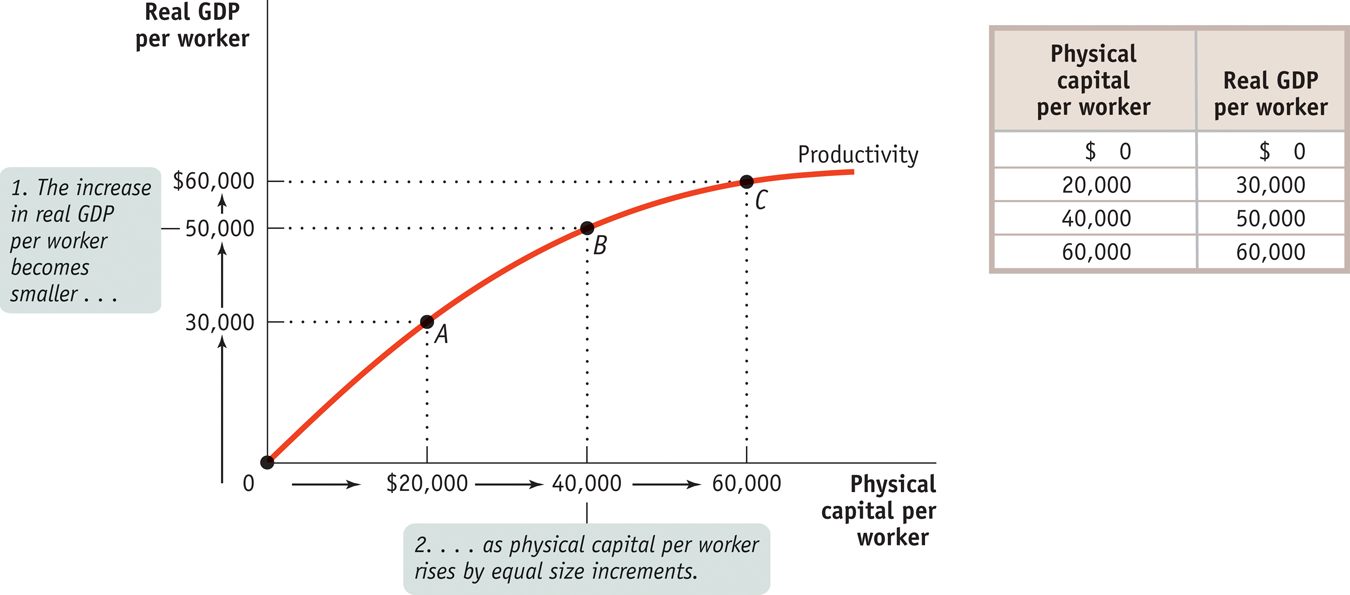
An aggregate production function exhibits diminishing returns to physical capital when, holding the amount of human capital per worker and the state of technology fixed, each successive increase in the amount of physical capital per worker leads to a smaller increase in productivity.
To see why the relationship between physical capital per worker and productivity exhibits diminishing returns, think about how having farm equipment affects the productivity of farmworkers. A little bit of equipment makes a big difference: a worker equipped with a tractor can do much more than a worker without one. And a worker using more expensive equipment will, other things equal, be more productive: a worker with a $40,000 tractor will normally be able to cultivate more farmland in a given amount of time than a worker with a $20,000 tractor because the more expensive machine will be more powerful, perform more tasks, or both.
But will a worker with a $40,000 tractor, holding human capital and technology constant, be twice as productive as a worker with a $20,000 tractor? Probably not: there’s a huge difference between not having a tractor at all and having even an inexpensive tractor; there’s much less difference between having an inexpensive tractor and having a better tractor. And we can be sure that a worker with a $200,000 tractor won’t be 10 times as productive: a tractor can be improved only so much. Because the same is true of other kinds of equipment, the aggregate production function shows diminishing returns to physical capital.
Diminishing returns to physical capital imply a relationship between physical capital per worker and output per worker like the one shown in Figure 54-1. As the productivity curve for physical capital and the accompanying table illustrate, more physical capital per worker leads to more output per worker. But each $20,000 increment in physical capital per worker adds less to productivity.
As you can see from the table, there is a big payoff for the first $20,000 of physical capital: real GDP per worker rises by $30,000. The second $20,000 of physical capital also raises productivity, but not by as much: real GDP per worker goes up by only $20,000. The third $20,000 of physical capital raises real GDP per worker by only $10,000.
By comparing points along the curve you can also see that as physical capital per worker rises, output per worker also rises—
It’s important to realize that diminishing returns to physical capital is an “other things equal” phenomenon: additional amounts of physical capital are less productive when the amount of human capital per worker and the technology are held fixed. Diminishing returns may disappear if we increase the amount of human capital per worker, or improve the technology, or both at the same time the amount of physical capital per worker is increased.
For example, a worker with a $40,000 tractor who has also been trained in the most advanced cultivation techniques may in fact be more than twice as productive as a worker with only a $20,000 tractor and no additional human capital. But diminishing returns to any one input—
Growth Accounting
In practice, all the factors contributing to higher productivity rise during the course of economic growth: both physical capital and human capital per worker increase, and technology advances as well. To disentangle the effects of these factors, economists use growth accounting, which estimates the contribution of each major factor in the aggregate production function to economic growth. For example, suppose the following are true:
- The amount of physical capital per worker grows 3% a year.
- Each 1% rise in physical capital per worker, holding human capital and technology constant, raises output per worker by one-
third of 1%, or 0.33%.
Growth accounting estimates the contribution of each major factor in the aggregate production function to economic growth.
In that case, we would estimate that growing physical capital per worker is responsible for 3% × 0.33 = 1 percentage point of productivity growth per year. A similar but more complex procedure is used to estimate the effects of growing human capital. The procedure is more complex because there aren’t simple dollar measures of the quantity of human capital.
Growth accounting allows us to calculate the effects of greater physical and human capital on economic growth. But how can we estimate the effects of technological progress? We do so by estimating what is left over after the effects of physical and human capital have been taken into account. For example, let’s imagine that there was no increase in human capital per worker so that we can focus on changes in physical capital and in technology.

In Figure 54-2, the lower curve shows the same hypothetical relationship between physical capital per worker and output per worker shown in Figure 54-1. Let’s assume that this was the relationship given the technology available in 1942. The upper curve also shows a relationship between physical capital per worker and productivity, but this time given the technology available in 2012. (We’ve chosen a 70-
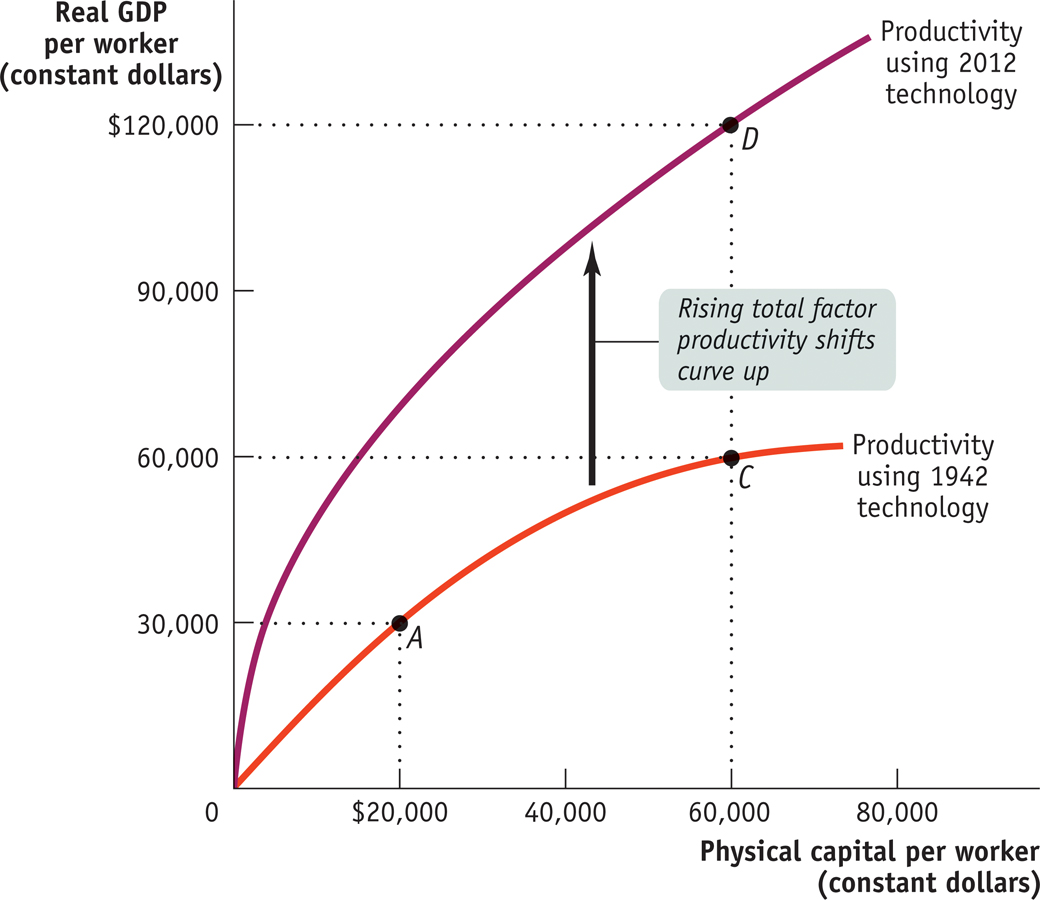
Let’s assume that between 1942 and 2012 the amount of physical capital per worker rose from $20,000 to $60,000. If this increase in physical capital per worker had taken place without any technological progress, the economy would have moved from A to C: output per worker would have risen, but only from $30,000 to $60,000, or 1% per year (using the Rule of 70 tells us that a 1% growth rate over 70 years doubles output). In fact, however, the economy moved from A to D: output rose from $30,000 to $120,000, or 2% per year. There was an increase in both physical capital per worker and technological progress, which shifted the aggregate production function.
Total factor productivity is the amount of output that can be achieved with a given amount of factor inputs.
In this case, 50% of the annual 2% increase in productivity—
Most estimates find that increases in total factor productivity are central to a country’s economic growth. We believe that observed increases in total factor productivity in fact measure the economic effects of technological progress. All of this implies that technological change is crucial to economic growth. The Bureau of Labor Statistics estimates the growth rate of both labor productivity and total factor productivity for nonfarm business in the United States. According to the Bureau’s estimates, during the past 70 years, only about half of the productivity in the economy is explained by increases in physical and human capital per worker; the rest is explained by rising total factor productivity—
THE INFORMATION TECHNOLOGY PARADOX
From the early 1970s through the mid-
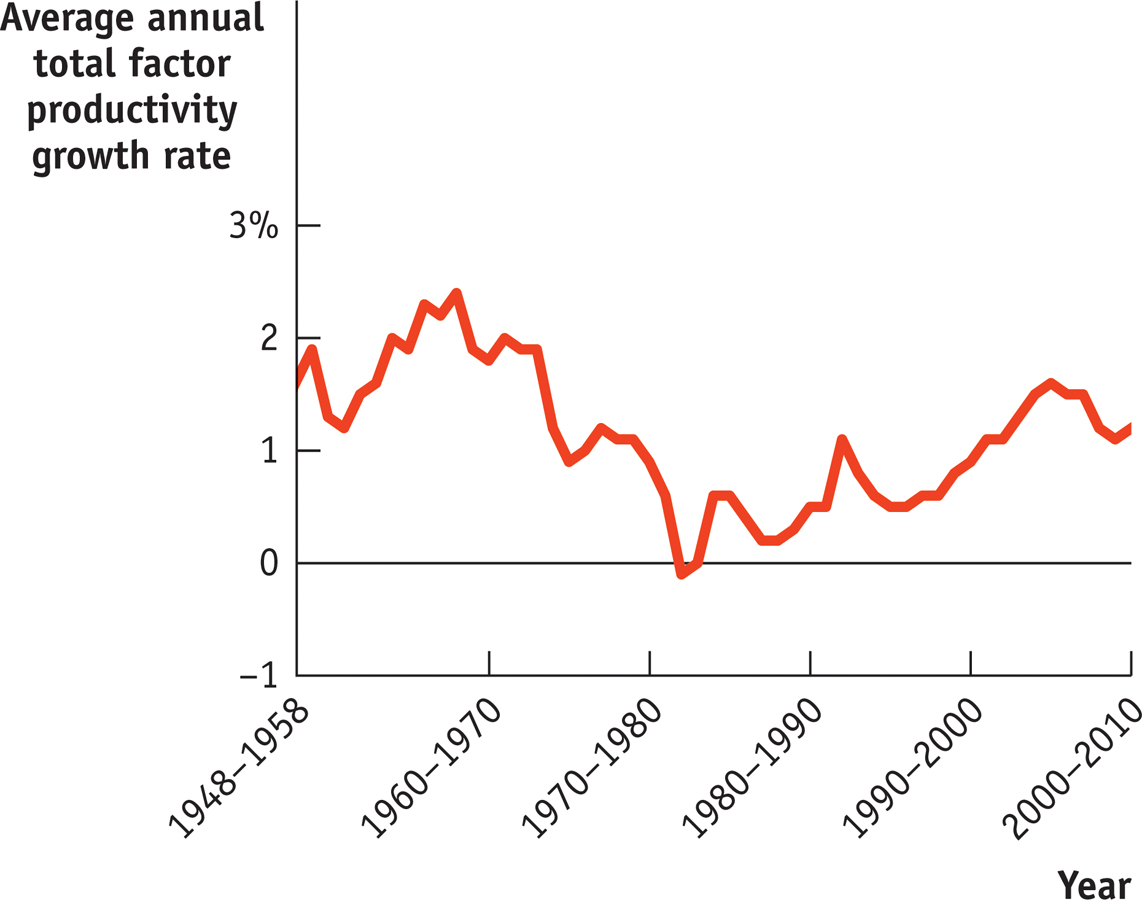
Many economists were puzzled by the slowdown in total factor productivity growth after 1973, since in other ways the era seemed to be one of rapid technological progress. Modern information technology really began with the development of the first microprocessor—
Yet the rate of growth of total factor productivity remained stagnant. In a famous remark, MIT economics professor and Nobel laureate Robert Solow, a pioneer in the analysis of economic growth, declared that the information technology revolution could be seen everywhere except in the economic statistics. Why didn’t information technology show large rewards?
Paul David, a Stanford University economic historian, offered a theory and a prediction. He pointed out that 100 years earlier another miracle technology—
For example, a traditional factory around 1900 was a multistory building, with the machinery tightly crowded together and designed to be powered by a steam engine in the basement. This design had problems: it was very difficult to move people and materials around. Yet owners who electrified their factories initially maintained the multistory, tightly packed layout. Only with the switch to spread-
David suggested that the same phenomenon was happening with information technology. Productivity, he predicted, would take off when people really changed their way of doing business to take advantage of the new technology—
What About Natural Resources?
In our discussion so far, we haven’t mentioned natural resources, which certainly have an effect on productivity. Other things equal, countries that are abundant in valuable natural resources, such as highly fertile land or rich mineral deposits, have higher real GDP per capita than less fortunate countries. The most obvious modern example is the Middle East, where enormous oil deposits have made a few sparsely populated countries very rich. For example, Kuwait has about the same level of real GDP per capita as Germany, but Kuwait’s wealth is based on oil, not manufacturing, the source of Germany’s high output per worker.
But other things are often not equal. In the modern world, natural resources are a much less important determinant of productivity than human or physical capital for the great majority of countries. For example, some nations with very high real GDP per capita, such as Japan, have very few natural resources. Some resource-
Historically, natural resources played a much more prominent role in determining productivity. In the nineteenth century, the countries with the highest real GDP per capita were those abundant in rich farmland and mineral deposits: the United States, Canada, Argentina, and Australia. As a consequence, natural resources figured prominently in the development of economic thought.
In a famous book published in 1798, An Essay on the Principle of Population, the English economist Thomas Malthus made the fixed quantity of land in the world the basis of a pessimistic prediction about future productivity. As population grew, he pointed out, the amount of land per worker would decline. And this, other things equal, would cause productivity to fall.
His view, in fact, was that improvements in technology or increases in physical capital would lead only to temporary improvements in productivity because they would always be offset by the pressure of rising population and more workers on the supply of land. In the long run, he concluded, the great majority of people were condemned to living on the edge of starvation. Only then would death rates be high enough and birth rates low enough to prevent rapid population growth from outstripping productivity growth.
It hasn’t turned out that way, although many historians believe that Malthus’s prediction of falling or stagnant productivity was valid for much of human history. Population pressure probably did prevent large productivity increases until the eighteenth century. But in the time since Malthus wrote his book, any negative effects on productivity from population growth have been far outweighed by other, positive factors—
Is World Growth Sustainable?
Sustainable long-
Some skeptics have expressed doubt about whether sustainable long-
In 1972 a group of scientists made a big splash with a book titled The Limits to Growth, which argued that long-
These concerns at first seemed to be validated by a sharp rise in resource prices in the 1970s, then came to seem foolish when resource prices fell sharply in the 1980s. After 2005, however, resource prices rose sharply again, leading to renewed concern about resource limitations to growth. Figure 54-4 shows the real price of oil—
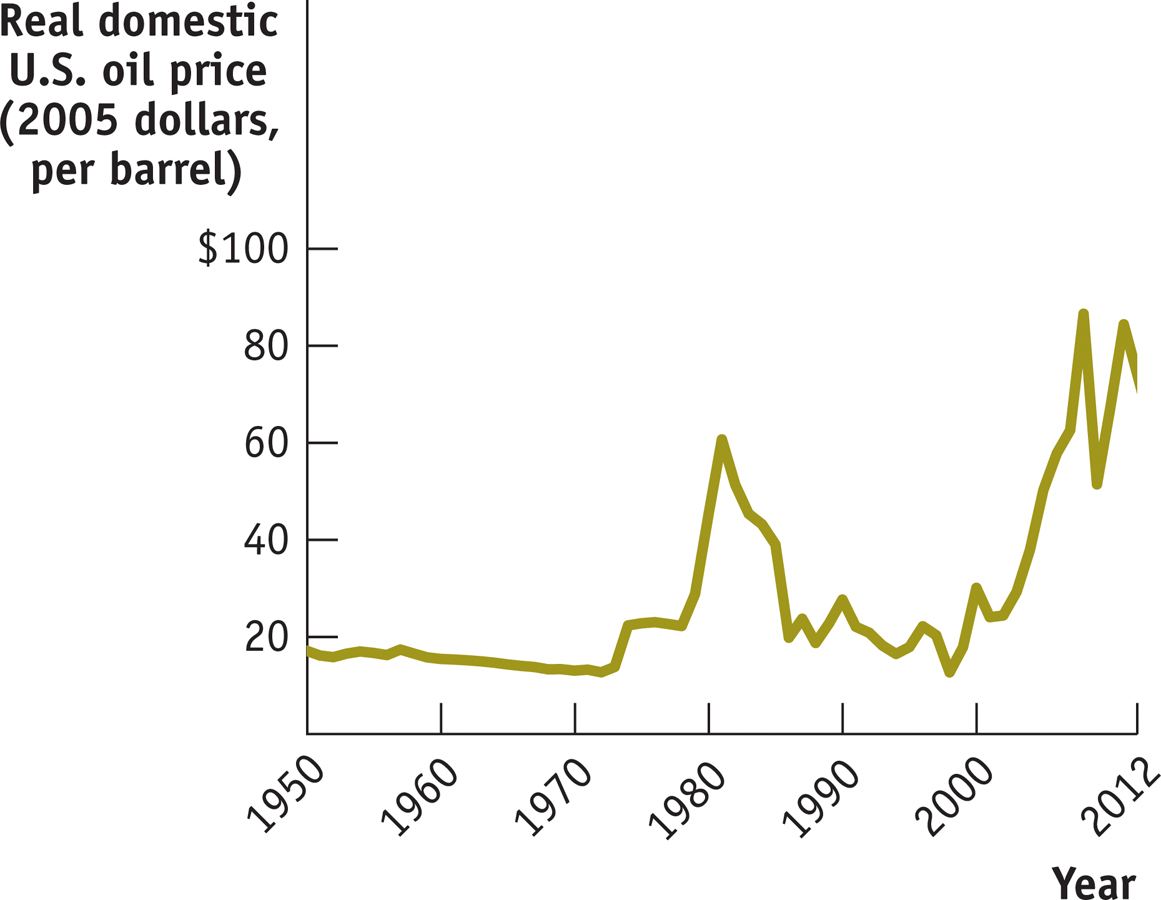
Differing views about the impact of limited natural resources on long-
1. How Large are The Supplies of Key Natural Resources?It’s mainly up to geologists to answer this question. And the response changes as new technologies, such as hydraulic fracking, are developed, allowing access to previously inaccessible oil and natural gas resources. Unfortunately, there’s wide disagreement among the experts, especially about the prospects for future oil production.
Some analysts believe that there is enough untapped oil in the ground that world oil production can continue to rise for several decades. Others, including a number of oil company executives, believe that the growing difficulty of finding new oil fields will cause oil production to plateau—
2. How Effective Will Technology Be At Finding Alternatives to Natural Resources?This question will have to be answered by engineers. There’s no question that there are many alternatives to the natural resources currently being depleted, some of which are already being exploited. For example, oil extracted from Canadian tar sands is making a significant contribution to world oil supplies, and the amount of electricity generated by wind and solar power continues to grow.
3. Can Long-
For example, after the sharp oil price increases of the 1970s, American consumers turned to smaller, more fuel-
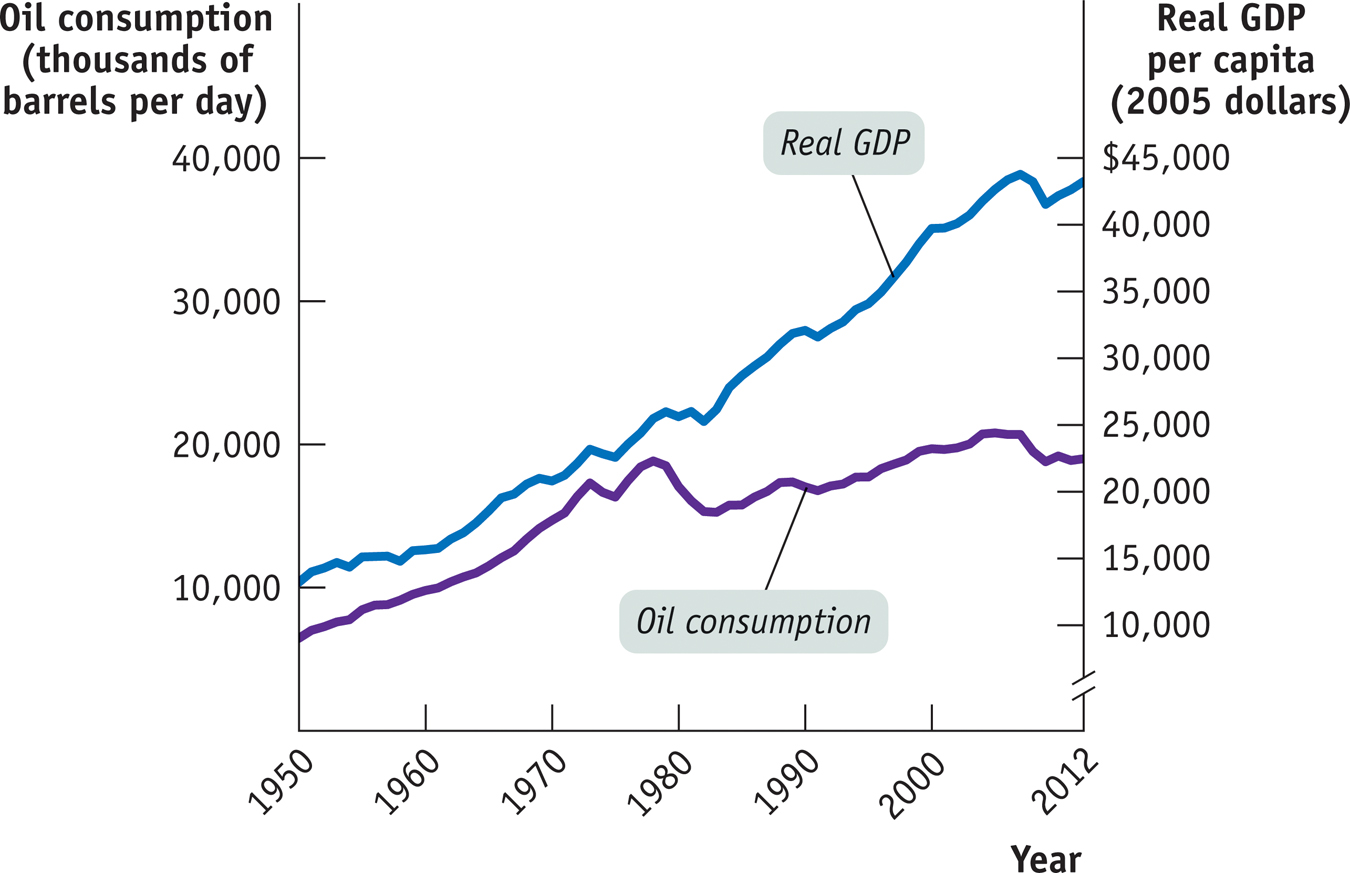

However, after 1973 the U.S. economy continued to deliver growth in real GDP per capita even as it substantially reduced the use of oil. This move toward conservation paused after 1990, as low real oil prices encouraged consumers to shift back to gas-
Given such responses to prices, economists generally tend to see resource scarcity as a problem that modern economies handle fairly well, and so not as a fundamental limit to long-
Economic Growth and the Environment
Economic growth, other things equal, tends to increase the human impact on the environment. For example, China’s spectacular economic growth has also brought a spectacular increase in air pollution in that nation’s cities. But again, other things aren’t necessarily equal: countries can and do take action to protect their environments.
In fact, air and water quality in today’s advanced countries is generally much better than it was a few decades ago. London’s famous “fog”—actually a form of air pollution, which killed more than 4,000 people during a two-
Despite these past environmental success stories, there is widespread concern today about the environmental impacts of continuing economic growth, reflecting a change in the scale of the problem. Environmental success stories have mainly involved dealing with local impacts of economic growth, such as the effect of widespread car ownership on air quality in the Los Angeles basin. Today, however, we are faced with global environmental issues—
The biggest of these issues involves the impact of fossil-
The problem of climate change is clearly linked to economic growth. Figure 54-6 shows carbon dioxide emissions from the United States, Europe, and China since 1980. Historically, the wealthy nations have been responsible for the bulk of these emissions because they have consumed far more energy per person than poorer countries. As China and other emerging economies have grown, however, they have begun to consume much more energy and emit much more carbon dioxide.
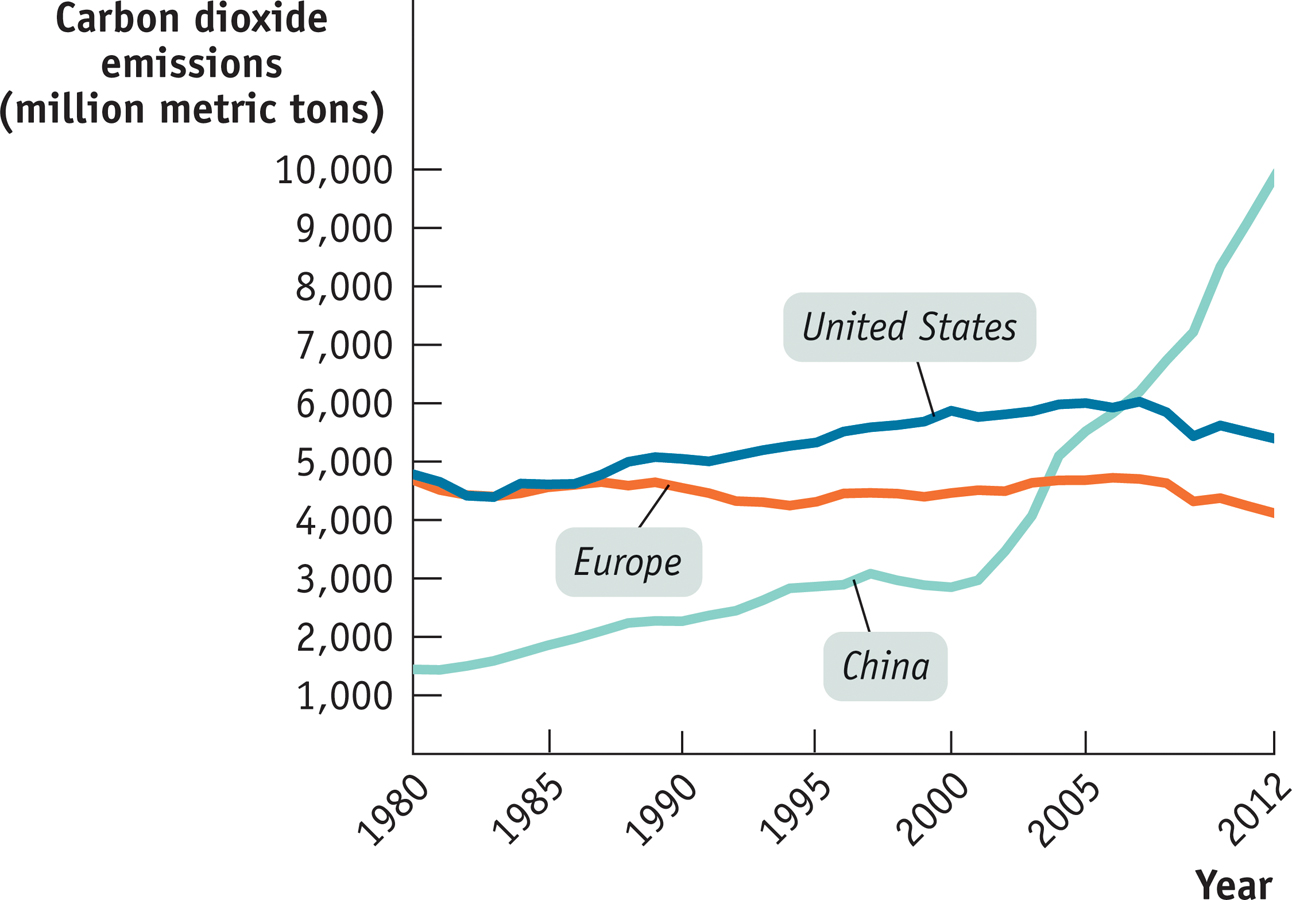
Is it possible to continue long-
The big question is how to make all of this happen. Unlike resource scarcity, environmental problems don’t automatically provide incentives for changed behavior. Pollution is an example of a negative externality, a cost that individuals or firms impose on others without having to offer compensation. In the absence of government intervention, individuals and firms have no incentive to reduce negative externalities, which is why it took regulation to reduce air pollution in America’s cities.
So there is a broad consensus among economists—

There are also several aspects of the climate change problem that make it much more difficult to deal with than, say, smog in Los Angeles. One is the problem of taking the long view. The impact of greenhouse gas emissions on the climate is very gradual: carbon dioxide put into the atmosphere today won’t have its full effect on the climate for several generations. As a result, there is the political problem of persuading voters to accept pain today in return for gains that will benefit future generations.
There is also a difficult problem of international burden sharing. As Figure 54-6 shows, rich economies have historically been responsible for most greenhouse gas emissions, but newly emerging economies like China are responsible for most of the recent growth. Inevitably, rich countries are reluctant to pay the price of reducing emissions only to have their efforts frustrated by rapidly growing emissions from new players. At the same time, countries like China, which are still relatively poor, consider it unfair that they should be expected to bear the burden of protecting an environment threatened by the past actions of rich nations.
The general moral of this story is that it is possible to reconcile long-
54
Solutions appear at the back of the book.
Check Your Understanding
Explain the effect of each of the following on the growth rate of productivity.
-
a. The amounts of physical and human capital per worker are unchanged, but there is significant technological progress.
Significant technological progress will result in a positive growth rate of productivity even though physical capital per worker and human capital per worker are unchanged. -
b. The amount of physical capital per worker grows, but the level of human capital per worker and technology are unchanged.
Productivity will grow, but due to diminishing marginal returns, each successive increase in physical capital per worker results in a smaller increase in productivity than the one before it.
-
The economy of Erehwon has grown 3% per year over the past 30 years. The labor force has grown at 1% per year, and the quantity of physical capital has grown at 4% per year. The average education level hasn’t changed. Estimates by economists say that each 1% increase in physical capital per worker, other things equal, raises productivity by 0.3%.
-
a. How fast has productivity in Erehwon grown?
If the economy has grown 3% per year and the labor force has grown 1% per year, then productivity—output per worker—has grown at approximately 3% − 1% = 2% per year. -
b. How fast has physical capital per worker grown?
If physical capital has grown 4% per year and the labor force has grown 1% per year, then physical capital per worker has grown at approximately 4% − 1% = 3% per year. -
c. How much has growing physical capital per worker contributed to productivity growth? What percentage of total productivity growth is that?
According to estimates, each 1% rise in physical capital, other things equal, increases productivity by 0.3%. So, as physical capital per worker has increased by 3%, productivity growth that can be attributed to an increase in physical capital per worker is 0.3 × 3% = 0.9%. As a percentage of total productivity growth, this is 0.9%/2% × 100% = 45%. -
d. How much has technological progress contributed to productivity growth? What percentage of total productivity growth is that?
If the rest of productivity growth is due to technological progress, then technological progress has contributed 2% − 0.9% = 1.1% to productivity growth. As a percentage of total productivity growth, this is 1.1%/2% × 100% = 55%.
-
Multinomics, Inc., is a large company with many offices around the country. It has just adopted a new computer system that will affect virtually every function performed within the company. Why might a period of time pass before employees’ productivity is improved by the new computer system? Why might there be a temporary decrease in employees’ productivity?
It will take time for workers to learn how to use the new computer system and to adjust their routines. And because there are often setbacks in learning a new system, such as accidentally erasing your computer files, productivity at Multinomics may decrease for a period of time.What is the link between greenhouse gas emissions and growth? What is the expected effect on growth from emissions reduction? Why is international burden sharing of greenhouse gas emissions reduction a contentious problem?
Growth increases a country’s greenhouse gas emissions. The current best estimates are that a large reduction in emissions will result in only a modest reduction in growth. The international burden sharing of greenhouse gas emissions reduction is contentious because rich countries are reluctant to pay the costs of reducing their emissions only to see newly emerging countries like China rapidly increase their emissions. Yet most of the current accumulation of gases is due to the past actions of rich countries. Poorer countries like China are equally reluctant to sacrifice their growth to pay for the past actions of rich countries.
Multiple-
Question
Which of the following is a source of increased productivity growth?
I. increased physical capital
II. increased human capital
III. technological progressA. B. C. D. E. Question
Which of the following is an example of physical capital?
A. B. C. D. E. Question
Which of the following is true of sustainable long-
run economic growth? A. B. C. D. E. Question
Which of the following statements is true of environmental quality?
A. B. C. D. E. Question
When economists talk about diminishing returns to physical capital, they mean that
A. B. C. D. E.
Critical-
Assume that between 1942 and 2012:
- The amount of physical capital per worker grows at 2% per year.
- Each 1% rise in physical capital per worker (holding human capital and technology constant) raises output per worker by ½ of a percent, or 0.5%.
- There is no growth in human capital.
- Real GDP per capita rises from $30,000 to $60,000.
Growing physical capital per worker is responsible for how much productivity growth per year? Show your calculation.
Growing physical capital per worker is responsible for 1% productivity growth per year. 2% × 0.5 = 1%By how much did total factor productivity grow over the time period? Explain.
There was no growth in total factor productivity because there was no technological progress. According to the Rule of 70, over 70 years (from 1942 to 2012), a 1% growth rate would cause output to double. Real GDP per capita in this case doubled, as would be expected from a 1% productivity growth rate alone; therefore, there was no change in technological progress.
IT MAY BE DIMINISHED…BUT IT’S STILL POSITIVE
 If there are diminishing returns to physical capital per worker, does it mean that GDP per worker is falling?
If there are diminishing returns to physical capital per worker, does it mean that GDP per worker is falling?
 NO, it does not. An increase in physical capital per worker will never reduce productivity. but due to diminishing returns, at some point increasing the amount of physical capital per worker will no longer produce an economic payoff: at that point, the increase in output will be so small that it won’t be worth the cost of the additional physical capital.
NO, it does not. An increase in physical capital per worker will never reduce productivity. but due to diminishing returns, at some point increasing the amount of physical capital per worker will no longer produce an economic payoff: at that point, the increase in output will be so small that it won’t be worth the cost of the additional physical capital.
To answer the question, keep in mind what diminishing returns to physical capital per worker means and what it doesn’t mean. As we’ve seen, it is an “other things equal” statement: holding the amount of human capital per worker and the technology fixed, each successive increase in the amount of physical capital per worker results in a smaller increase in real GDP per worker. But this doesn’t mean that real GDP per worker eventually falls as more and more physical capital is added. It’s just that the increase in real GDP per worker gets smaller and smaller, while remaining at or above zero.
To learn more, see pages 179–
